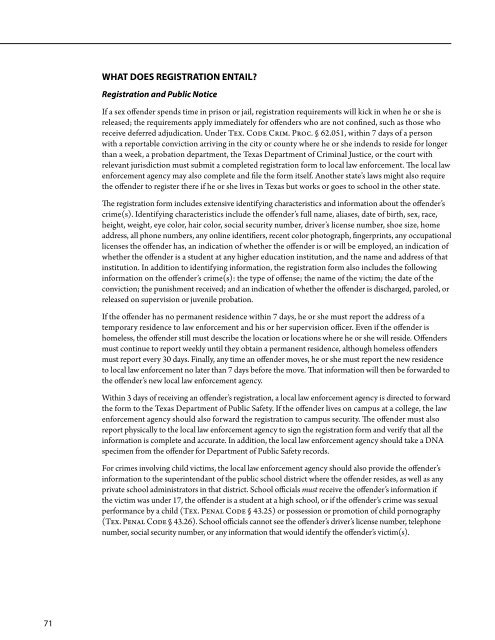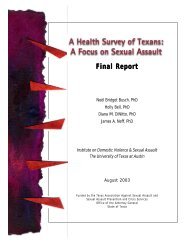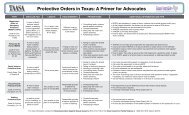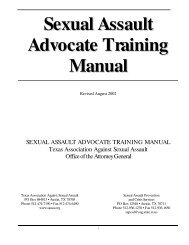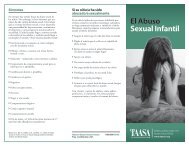Sexual aSSault LEGAL ADVOCACY MANUAL - Texas Association ...
Sexual aSSault LEGAL ADVOCACY MANUAL - Texas Association ...
Sexual aSSault LEGAL ADVOCACY MANUAL - Texas Association ...
You also want an ePaper? Increase the reach of your titles
YUMPU automatically turns print PDFs into web optimized ePapers that Google loves.
What Does Registration Entail?<br />
Registration and Public Notice<br />
If a sex offender spends time in prison or jail, registration requirements will kick in when he or she is<br />
released; the requirements apply immediately for offenders who are not confined, such as those who<br />
receive deferred adjudication. Under Tex. Code Crim. Proc. § 62.051, within 7 days of a person<br />
with a reportable conviction arriving in the city or county where he or she indends to reside for longer<br />
than a week, a probation department, the <strong>Texas</strong> Department of Criminal Justice, or the court with<br />
relevant jurisdiction must submit a completed registration form to local law enforcement. The local law<br />
enforcement agency may also complete and file the form itself. Another state’s laws might also require<br />
the offender to register there if he or she lives in <strong>Texas</strong> but works or goes to school in the other state.<br />
The registration form includes extensive identifying characteristics and information about the offender’s<br />
crime(s). Identifying characteristics include the offender’s full name, aliases, date of birth, sex, race,<br />
height, weight, eye color, hair color, social security number, driver’s license number, shoe size, home<br />
address, all phone numbers, any online identifiers, recent color photograph, fingerprints, any occupational<br />
licenses the offender has, an indication of whether the offender is or will be employed, an indication of<br />
whether the offender is a student at any higher education institution, and the name and address of that<br />
institution. In addition to identifying information, the registration form also includes the following<br />
information on the offender’s crime(s): the type of offense; the name of the victim; the date of the<br />
conviction; the punishment received; and an indication of whether the offender is discharged, paroled, or<br />
released on supervision or juvenile probation.<br />
If the offender has no permanent residence within 7 days, he or she must report the address of a<br />
temporary residence to law enforcement and his or her supervision officer. Even if the offender is<br />
homeless, the offender still must describe the location or locations where he or she will reside. Offenders<br />
must continue to report weekly until they obtain a permanent residence, although homeless offenders<br />
must report every 30 days. Finally, any time an offender moves, he or she must report the new residence<br />
to local law enforcement no later than 7 days before the move. That information will then be forwarded to<br />
the offender’s new local law enforcement agency.<br />
Within 3 days of receiving an offender’s registration, a local law enforcement agency is directed to forward<br />
the form to the <strong>Texas</strong> Department of Public Safety. If the offender lives on campus at a college, the law<br />
enforcement agency should also forward the registration to campus security. The offender must also<br />
report physically to the local law enforcement agency to sign the registration form and verify that all the<br />
information is complete and accurate. In addition, the local law enforcement agency should take a DNA<br />
specimen from the offender for Department of Public Safety records.<br />
For crimes involving child victims, the local law enforcement agency should also provide the offender’s<br />
information to the superintendant of the public school district where the offender resides, as well as any<br />
private school administrators in that district. School officials must receive the offender’s information if<br />
the victim was under 17, the offender is a student at a high school, or if the offender’s crime was sexual<br />
performance by a child (Tex. Penal Code § 43.25) or possession or promotion of child pornography<br />
(Tex. Penal Code § 43.26). School officials cannot see the offender’s driver’s license number, telephone<br />
number, social security number, or any information that would identify the offender’s victim(s).<br />
71


